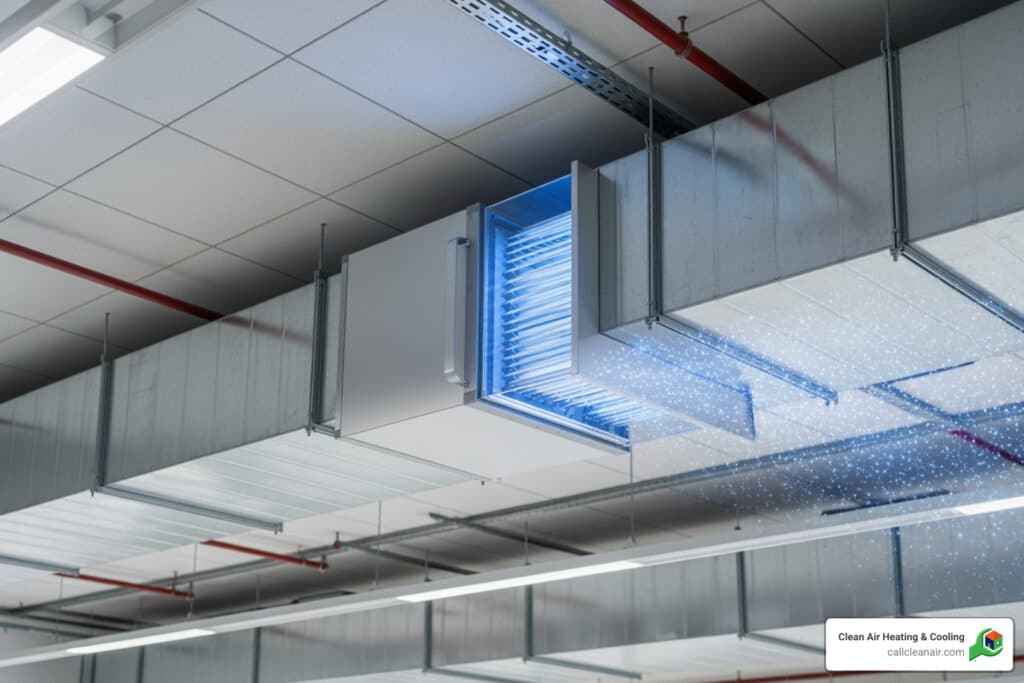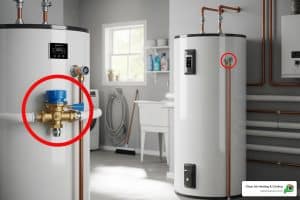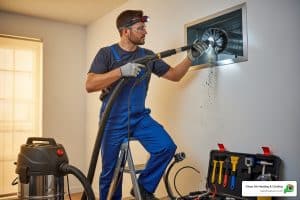Why Indoor Air Quality is Your Business’s Most Important Asset
HVAC air purification systems integrate with your existing heating and cooling system to remove pollutants, allergens, and pathogens from the air in your commercial building. These systems go beyond basic filtration to actively clean and sanitize the air your employees and customers breathe.
Key HVAC Air Purification Methods:
- High-efficiency filters (MERV 13-16) – Capture particles as small as 0.3 microns including dust, pollen, and bacteria
- UV-C germicidal lights – Destroy DNA/RNA of viruses, bacteria, and mold spores
- Activated carbon filtration – Remove odors and volatile organic compounds (VOCs)
- Ionization systems – Neutralize airborne contaminants and improve particle capture
- Whole-building integration – Purify air continuously through your existing ductwork
The stakes for commercial indoor air quality have never been higher. According to EPA research, indoor air can be 2-5 times more polluted than outdoor air, and sometimes up to 100 times worse. Since employees spend up to 90% of their time indoors, the air they breathe is a critical factor in their health, productivity, and job satisfaction.
Poor indoor air quality directly impacts your bottom line through increased sick days, reduced cognitive function, and higher employee turnover. Customers and clients also notice the difference between a space with fresh air and one that feels stuffy or has lingering odors.
Common Commercial Air Pollutants:
- Dust, pollen, and allergens from HVAC systems and outdoor sources
- Volatile organic compounds (VOCs) from cleaning supplies, furniture, and equipment
- Airborne pathogens including viruses, bacteria, and mold spores
- Smoke and odors from various sources
- Carbon dioxide buildup from occupancy
As Colin Matei, Owner and President of Clean Air Heating & Cooling, I’ve helped countless commercial clients transform their indoor environments through strategic HVAC air purification solutions that integrate seamlessly with existing systems. My experience has shown that the right air purification approach not only creates healthier spaces but also reduces HVAC maintenance costs and energy consumption.
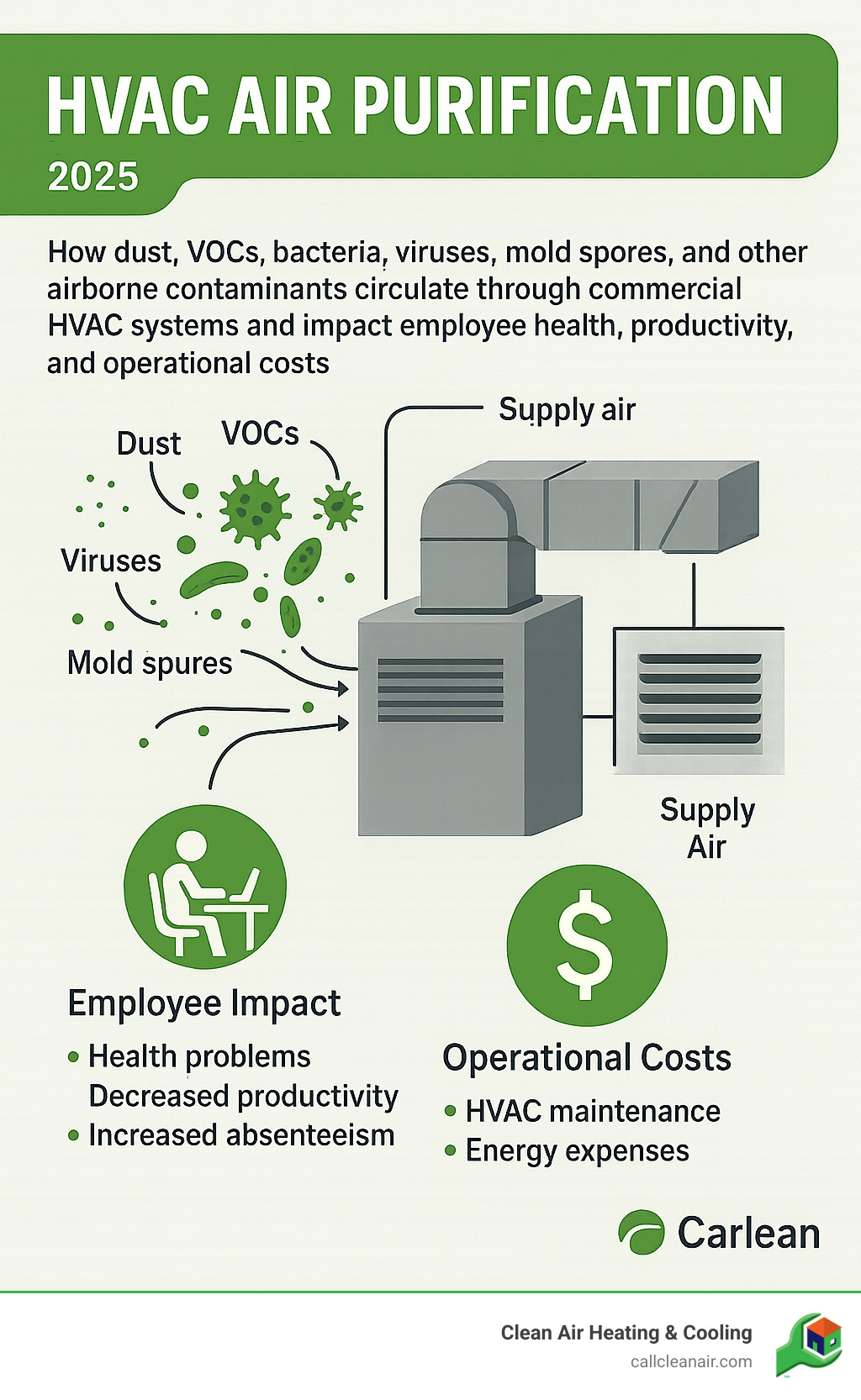
The Core Technologies of Commercial HVAC Air Purification
Think of HVAC air purification as your building’s immune system. Just like your body has multiple layers of defense against illness, effective commercial air cleaning uses several technologies working together to create the healthiest possible environment for your employees and customers.
Differentiating Standard HVAC Filters from Advanced Filtration
A basic filter in your HVAC system isn’t designed to clean your air; it’s there to protect your equipment. Most commercial buildings use standard 1-inch disposable filters that keep large dust and debris from damaging HVAC components. However, they are ineffective against the tiny particles that affect human health.
The real difference lies in MERV ratings (Minimum Efficiency Reporting Value), which measure how well a filter captures particles. Basic filters (MERV 1-4) only catch lint and visible dust, while the particles that cause respiratory problems, trigger allergies, and carry viruses sail right through.
Advanced filtration systems flip this equation. Instead of just protecting your equipment, they’re designed to protect your people. These systems use MERV 13 and higher filters that can capture particles as small as 0.3 microns – that’s where bacteria, mold spores, and many allergens live.
The magic happens when you combine high-efficiency filtration with other purification technologies. Suddenly, you’re not just trapping particles – you’re actively cleaning and sanitizing the air throughout your entire building. What is a MERV rating?
High-Efficiency Particulate Air (HEPA) and High-MERV Filtration
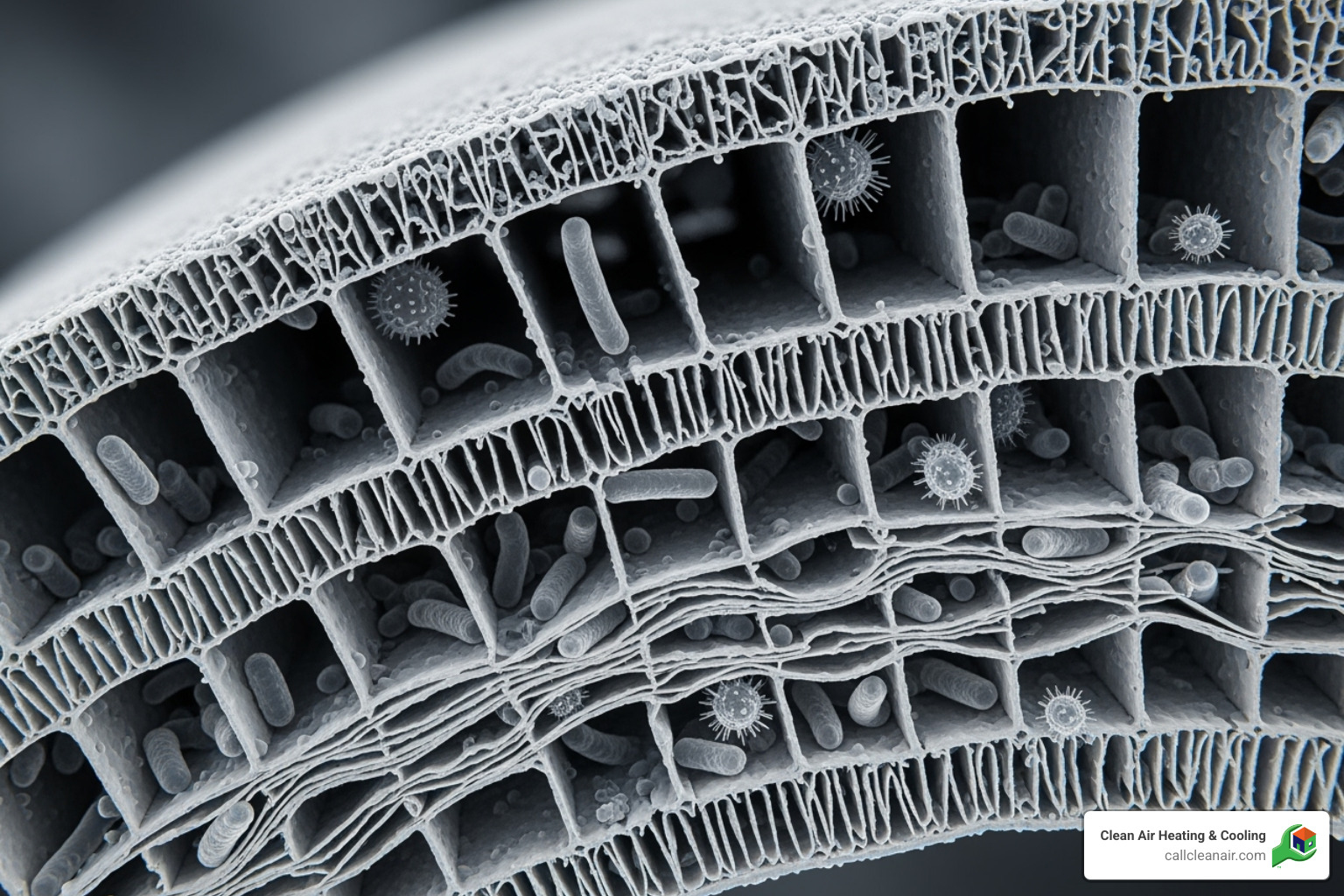
When people talk about serious air cleaning, HEPA filters are usually the first thing mentioned. And for good reason – these powerhouses capture 99.97% of particles at 0.3 microns. To put that in perspective, a human hair is about 100 microns wide, so we’re talking about incredibly tiny stuff.
HEPA and high-MERV filtration excel at removing the pollutants that matter most to your business: dust that settles on equipment, pollen that triggers employee allergies, pet dander from service animals, mold spores that can cause health issues, and bacteria that contribute to sick building syndrome.
However, higher MERV ratings create more resistance to airflow, known as pressure drop. If your HVAC system isn’t designed for it, a high-efficiency filter can cause reduced airflow, higher energy bills, and system strain. This is why newer technologies are so exciting. Some advanced filters achieve MERV 13 performance with less pressure drop than older MERV 8 filters, while others capture particles as small as 0.007 microns—40 times smaller than standard HEPA efficiency. These systems deliver medical-grade air cleaning without overworking your HVAC equipment.
Germicidal UV-C Light Purification
While filters are great at catching particles, they can’t kill them. That’s where UV-C germicidal light becomes your secret weapon against airborne pathogens.
UV-C light works by scrambling the DNA and RNA of viruses, bacteria, and mold spores, preventing them from reproducing or causing infections. In commercial HVAC systems, we install UV-C lamps in the ductwork or near air conditioning coils. Placing them near the coils is particularly effective, as it prevents mold and bacteria growth on the coils themselves. Clean coils run more efficiently, leading to lower energy costs and better system performance.
Here’s an important safety note: older UV systems sometimes produced ozone, which isn’t good for human health. Modern ozone-free UV-C systems are certified safe and effective. The CDC, WHO, and ASHRAE all recommend UV-C technology for air disinfection in commercial buildings. CDC recommendations for UVC disinfection
Active Air Quality Solutions for Commercial HVAC
The newest generation of HVAC air purification goes beyond just filtering and sterilizing. These active systems actually hunt down pollutants and neutralize them throughout your building.
Air quality monitors are the brains of modern purification systems. These smart sensors track particle levels, CO2, and volatile organic compounds (VOCs) in real-time. When air quality drops, the system automatically ramps up to restore clean conditions, acting as a 24/7 air quality manager.
In-duct purification technologies work while air circulates through your existing system. Bipolar ionization releases charged particles that make pollutants clump together, making them easier for filters to catch. Activated carbon components tackle the chemical side of air quality, absorbing odors and VOCs from cleaning supplies, new furniture, and office equipment.
For businesses dealing with specific challenges like cooking odors, chemical fumes, or high occupancy, advanced purification technologies can target these problems directly. The key is choosing systems with UL 2998 certification for zero ozone emissions – you want cleaner air, not new problems.
The most effective approach combines multiple technologies. High-MERV filtration catches particles, UV-C light neutralizes pathogens, and active purification tackles odors and chemicals. Together, they create a comprehensive defense system that keeps your indoor air consistently clean and healthy.
The Business Case: Benefits of a Whole-Building System
When you’re running a business, every investment needs to make sense from both a people and profit perspective. HVAC air purification systems deliver on both fronts, creating healthier environments while generating measurable returns that justify the investment.
Enhancing Health, Wellness, and Productivity
Poor indoor air quality creates a cascade of problems that directly impact your bottom line. Allergies and asthma symptoms flare up when dust, pollen, and mold spores circulate through your building, causing employees to feel miserable instead of focusing on their work.
Respiratory illnesses spread faster in buildings with poor air quality. Viruses and bacteria hitch rides on airborne particles, moving from person to person through your HVAC system. The result? More sick days, reduced productivity, and the frustrating cycle of illnesses making their way through your entire team.

Furthermore, improved cognitive function occurs when you clean the air. Studies show high levels of CO2 and volatile organic compounds (VOCs) slow thinking and reduce concentration. Clean air helps your team think more clearly and work more effectively.
A comprehensive HVAC air purification system addresses all of these issues by removing airborne pathogens, neutralizing allergens, and creating an environment where people can truly thrive. Your employees feel better, work more productively, and take fewer sick days. Your customers and clients notice the difference too – clean, fresh air creates a more welcoming and professional atmosphere that encourages repeat business.
Improving Energy Efficiency and Reducing Costs
The financial benefits of HVAC air purification often surprise business owners. What starts as an investment in health quickly becomes a driver of operational savings.
Lower HVAC strain happens naturally when your system doesn’t have to fight through layers of dust and debris. Dirty coils and clogged components force your heating and cooling equipment to work overtime, consuming more energy and wearing out faster. Advanced purification systems, especially those with UV-C lights that keep coils clean, let your HVAC system run more efficiently and last longer.
Reduced maintenance costs add up quickly. Clean coils need less frequent servicing, and advanced filter technologies can extend filter life by 2-3 times compared to standard options. Some of our clients have seen their maintenance schedules become much more manageable and predictable.
The energy savings from optimized ventilation create ongoing benefits. When your indoor air is effectively cleaned, ASHRAE standards allow you to bring in less outdoor air that needs heating or cooling. This can lead to substantial utility bill reductions – in fact, we’re so confident in these savings that we offer a 25% utility savings guarantee.
Extended system lifespan means delaying major capital expenses. When your HVAC equipment isn’t constantly battling contamination, it simply lasts longer and performs better throughout its life.
Whole-Building Coverage: The Advantage Over Standalone Solutions
You might wonder why you need a whole-building HVAC air purification system instead of portable units. The answer is comprehensive coverage versus patchwork solutions. Portable purifiers only work for single rooms, creating an inconsistent experience. Covering an entire commercial space requires multiple units, which creates noise, takes up floor space, and needs individual maintenance.
A whole-building system works differently. It integrates directly into your existing HVAC ductwork, so every cubic foot of air that circulates through your building gets continuously cleaned and purified. Effectiveness becomes comprehensive and consistent – every room, every office, every common area benefits equally.
The cost comparison favors whole-building systems over time. Though the upfront investment is higher, you avoid the ongoing expense and hassle of maintaining and replacing multiple portable units. Maintenance is centralized and less frequent, handled on a building-wide schedule.
Noise levels stay low because the purification happens within your existing HVAC system rather than adding multiple humming devices throughout your space. Convenience means set-it-and-forget-it operation – no need to remember to turn units on and off or manage different settings in different rooms.
From an aesthetics standpoint, whole-building systems remain invisible. Your professional environment stays clean and uncluttered, without equipment taking up valuable floor space or disrupting your carefully planned layout.
The bottom line? A whole-building HVAC air purification system delivers uniform, continuous air quality improvement that benefits everyone in your building while simplifying maintenance and reducing long-term costs. It’s comprehensive protection that makes both health and financial sense.
Implementation: Integrating Purification into Your Commercial HVAC System
Getting the right HVAC air purification system for your business isn’t as simple as picking one off the shelf. Every commercial building has its own unique challenges and needs. That’s why we take the time to understand your specific situation before recommending any solutions.
Key Factors for Choosing the Right HVAC Air Purification System
Choosing the right system involves more than just square footage. While the size and layout of your space matter, the specific details of your building and its use are critical.
Building occupancy tells us a lot about your air quality needs. A busy restaurant kitchen faces completely different challenges than a quiet accounting firm. More people means more CO2, more particles stirred up, and generally more demand on your air cleaning system. We factor this into every recommendation.
Your specific air quality concerns are equally important. Maybe you’re dealing with persistent odors from a neighboring business, or perhaps you’re in a healthcare setting where pathogen control is critical. Some clients worry about dust affecting sensitive equipment, while others need to tackle chemical fumes from manufacturing processes. Understanding what keeps you up at night helps us choose the right technologies – whether that’s activated carbon filters for odors or UV-C lights for biological contaminants.
Your existing HVAC system’s compatibility is where our experience really counts. We’ve seen too many situations where someone installed a high-efficiency filter without considering whether their system could handle the increased resistance. This creates problems with airflow and can actually make your indoor air quality worse while driving up energy costs.
The Clean Air Delivery Rate (CADR) is a crucial metric measuring how much clean air a system produces per minute. A basic filter might have a CADR of 10, while advanced whole-building systems can deliver a CADR of 1200 or more. This higher number represents dramatically cleaner air throughout your building.
Ventilation effectiveness goes beyond simple air changes per hour to evaluate how well contaminants are actually removed from your space. We design systems that don’t just move air around, but genuinely improve what you’re breathing.
Installation and Sizing Considerations
Professional installation isn’t just recommended for commercial HVAC air purification systems – it’s absolutely essential. I’ve seen well-intentioned DIY attempts that not only failed to improve air quality but actually created new problems with system efficiency and airflow.
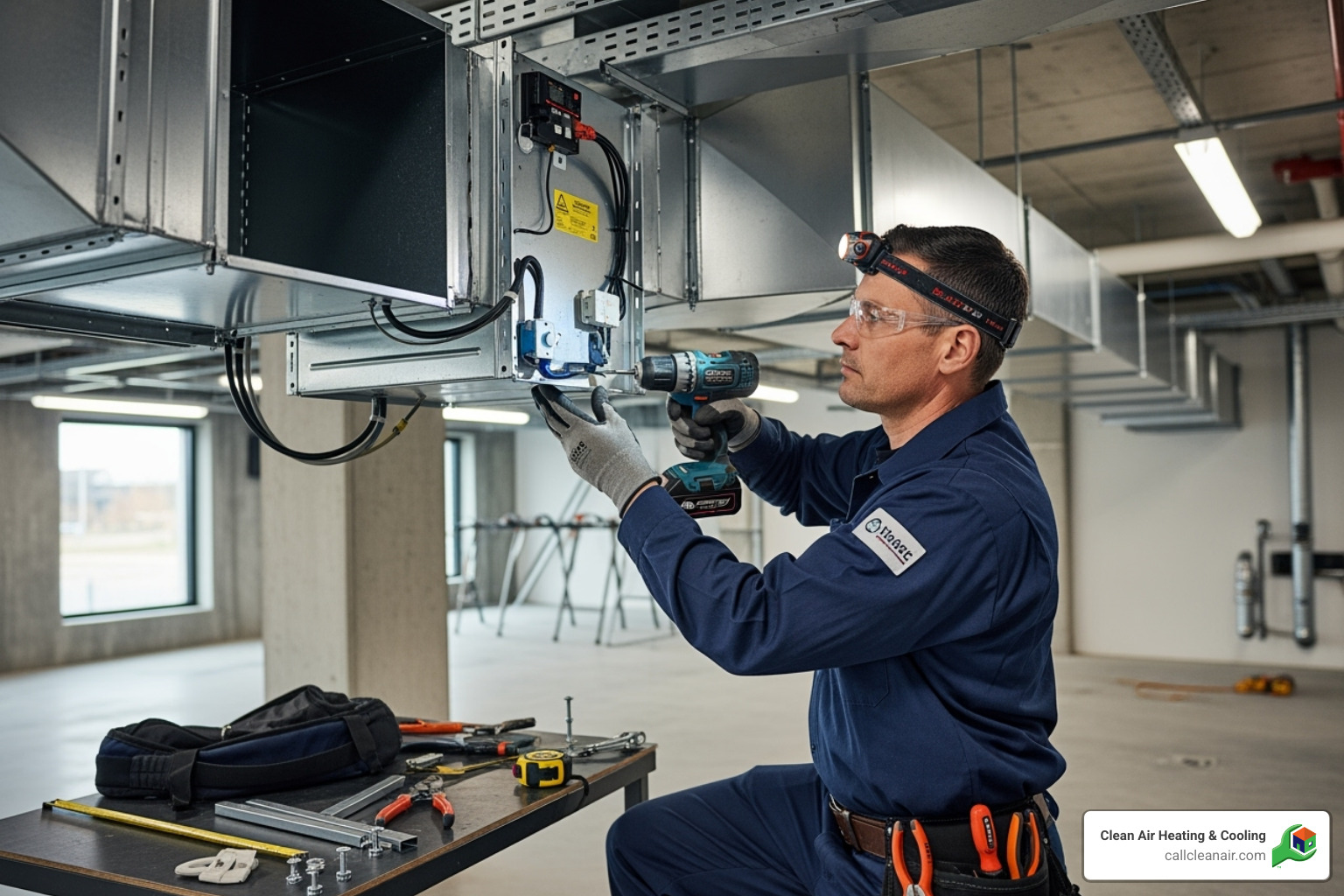
Our installation process starts with a comprehensive professional assessment. Certified technicians examine your entire HVAC system, from the main unit to the ductwork branches. We use specialized tools to find optimal installation points, measure static pressure, and evaluate system capacity to understand how air moves through your building.
Ductwork modifications might sound intimidating, but they’re usually minor adjustments that make a major difference in performance. Installing UV-C lights near your coils, fitting high-efficiency filter banks, or adding ionization units requires precise placement and proper sealing. Even small air leaks can significantly reduce system effectiveness.
System sizing and airflow analysis is where the science really matters. We calculate your building’s air volume, turnover rates, and specific load requirements. This detailed analysis ensures that your new purification components improve rather than hinder your HVAC system’s performance. We strictly follow ASHRAE standards for ventilation to guarantee optimal and safe operation.
The goal is seamless integration that improves your air quality while maintaining or even enhancing your system’s efficiency. When done correctly, you shouldn’t notice any difference in comfort or noise levels – just cleaner, fresher air.
Maintenance and Upkeep for Your HVAC Air Purification System
Like any investment in your business, your HVAC air purification system needs regular care to deliver consistent results. The good news is that maintenance requirements are generally straightforward and predictable.
Filter replacement is your most frequent maintenance task, but the schedule varies significantly based on your system type and environment. Standard 1-inch filters typically need changing every 1-3 months, while higher-quality pleated filters (MERV 8-16) usually last 3-6 months. Advanced systems like deeper 4-inch filters or electrically-improved filters can often go 6-12 months between changes. Some of our clients with advanced filtration systems find their filters lasting even longer, which helps offset the initial investment.
UV bulb replacement happens about once a year for most systems, though some newer bulbs can last up to two years. Here’s something important to know: UV bulbs might still be glowing after their effective lifespan ends. They lose their germicidal power gradually, so replacing them on schedule maintains your pathogen protection.
System cleaning keeps everything running smoothly. Components like ionization plates or electrostatic collectors need periodic cleaning to remove accumulated particles. Washable filters require regular attention too. The frequency depends on your specific environment and usage patterns.
Professional servicing is where we really add value. Our annual maintenance visits include inspecting all purification components, checking electrical connections, verifying proper airflow, and cleaning internal parts as needed. We catch small issues before they become expensive problems and ensure your system continues operating at peak efficiency.
Most of our commercial clients find that consistent professional maintenance actually saves money over time through improved system efficiency, extended equipment life, and fewer unexpected repairs. Plus, you have the peace of mind knowing your air quality investment is protected.
Frequently Asked Questions about Commercial Air Purification
As a business owner considering HVAC air purification, you probably have some questions. Over my years helping commercial clients in Whatcom, Skagit, Snohomish, and San Juan Counties, I’ve heard the same concerns come up again and again. Let me address the most common ones.
Do higher MERV-rated filters always mean better air quality?
While higher MERV filters capture smaller particles more effectively, simply installing the highest-rated filter isn’t always the best strategy for your business.
The key issue is something called pressure drop. Think of it like trying to breathe through a thick blanket versus a thin sheet. Higher MERV filters are denser, which means your HVAC system has to work much harder to push air through them.
If your system wasn’t designed for high-efficiency filtration, you’ll run into problems. Reduced airflow means less heating and cooling reaches your space, and ironically, less purified air too. Your energy bills will skyrocket as your equipment struggles against the restriction. Even worse, this constant strain can damage your HVAC system’s fan motor and other components, leading to expensive repairs or premature replacement.
For most commercial buildings, MERV ratings between 8 and 16 provide excellent particle removal without overwhelming your system. Beyond MERV 16, you typically need specialized equipment designed to handle the increased resistance.
The sweet spot is finding the highest MERV rating your specific system can handle efficiently. That’s why we always assess your existing equipment before recommending filtration upgrades. It’s about maximizing air quality while protecting your HVAC investment.
Can an HVAC air purification system remove odors and chemical fumes?
Yes, but it’s important to understand that standard particle filters (even HEPA) don’t remove gaseous pollutants like odors and chemical fumes.
Activated carbon filters are the game-changer here. These specialized filters work completely differently from particle filters. Their porous structure acts like a sponge for gas molecules, effectively trapping volatile organic compounds (VOCs) from sources like cleaning supplies, new furniture, paints, and office equipment.
If you’ve ever walked into a building and immediately noticed strong cleaning chemical smells or that “new carpet” odor, those are VOCs that standard filtration can’t touch. Activated carbon filters excel at removing these contaminants, leaving your space smelling fresh and clean.
Some advanced HVAC air purification systems go even further. Technologies like photocatalytic oxidation or bipolar ionization don’t just trap these compounds—they actually break them down at a molecular level. This means they eliminate the source of odors rather than just masking them.
For businesses dealing with persistent odors or significant VOC sources, incorporating these specialized technologies into your air purification strategy makes a dramatic difference in indoor air quality.
How often do commercial HVAC purification systems need to be serviced?
The maintenance schedule for your HVAC air purification system depends on the technologies you’ve chosen and your specific commercial environment.
Filter replacement is your most frequent task. Basic MERV-rated filters typically need changing every 1 to 3 months, especially in high-traffic commercial spaces. However, advanced high-efficiency filters often last much longer—anywhere from 6 to 12 months, and some specialized filters can even go up to 2 years before replacement.
UV-C bulbs need annual replacement to maintain their effectiveness at neutralizing pathogens. Even though the bulb might still be glowing, its germicidal power diminishes over time. We typically recommend changing these every 12 months, though some newer models can last up to 2 years.
Other components like ionization systems or electrostatic precipitators may need periodic cleaning to remove accumulated particles, but this varies significantly based on your specific air quality challenges.
Here’s my recommendation: schedule a professional inspection at least once a year, ideally alongside your regular HVAC maintenance. During these visits, we assess all components, recommend timely replacements, and ensure everything is operating at peak efficiency.
This proactive approach not only guarantees continuous clean air but also protects your overall HVAC investment. Plus, it gives you peace of mind knowing your air purification system is working properly to protect your employees and customers.
Partner with the Experts for a Healthier Business Environment
A high-performance HVAC air purification system is a critical investment in the health of your employees, the satisfaction of your customers, and the efficiency of your operations. By understanding the available technologies and their benefits, you can create a cleaner, safer, and more productive commercial space.
The air inside your building works 24/7, either supporting your business or undermining it. Poor indoor air quality leads to increased sick days, reduced cognitive function, and higher employee turnover. In contrast, clean air creates an environment where people feel energized, focused, and comfortable.
The air quality in your building is a silent factor influencing employee productivity, customer comfort, and well-being. Clients immediately notice if the air feels fresh or stuffy, and that first impression matters.
Advanced HVAC air purification isn’t just about meeting minimum standards—it’s about creating an exceptional environment that sets your business apart. Whether you’re dealing with seasonal allergies affecting your team, lingering odors from nearby businesses, or simply want to ensure the healthiest possible workspace, the right purification system makes a measurable difference.
For businesses in Whatcom, Skagit, Snohomish, and San Juan Counties, our team at Clean Air Heating & Cooling brings decades of expertise and a genuine commitment to improving your indoor environment. We’ve earned over 600+ stellar Google reviews because we listen to our clients’ specific concerns and deliver solutions that actually work.
Our approach starts with understanding your unique situation. Every commercial space has different challenges—from the busy restaurant dealing with cooking odors to the office building where employees struggle with seasonal allergies. We take the time to assess your current system, identify your primary air quality concerns, and recommend the most effective HVAC air purification technologies for your specific needs.
What sets us apart is our 25% utility savings guarantee. We don’t just improve your air quality; we optimize your entire HVAC system for maximum efficiency. Our clients often find their new purification system reduces energy costs while dramatically improving indoor air quality.
The installation process is seamless and professional. Our certified technicians work around your business schedule, ensuring minimal disruption to your daily operations. We handle everything from the initial assessment to ongoing maintenance, so you can focus on running your business while we take care of keeping your air clean and healthy.
Ready to transform your business environment with cleaner, healthier air? Let’s start with a conversation about your specific needs and goals. We’re here to help you create the kind of workspace where everyone thrives.
Improve your building’s air with professional duct cleaning services

